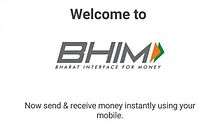BHIM
 | |
| Developer(s) | National Payments Corporation of India |
|---|---|
| Initial release | 30 December 2016 |
| Platform |
Google Play App Store |
| Available in | English, Hindi, Bengali, Tamil, Telugu, Kannada, Malayalam, Odia, Gujarati[1] |
| Type | Payment |
| Website | NPCI Portal |
BHIM (Bharat Interface for Money) is a Mobile App developed by National Payments Corporation of India (NPCI), based on the Unified Payment Interface (UPI). It was launched by Narendra Modi, the Prime Minister of India, at a Digi Dhan mela at Talkatora Stadium in New Delhi on 30 December 2016. It has been named after Dr. Bhimrao R. Ambedkar and is intended to facilitate e-payments directly through banks and as part of the 2016 Indian banknote demonetisation and drive towards cashless transactions.[2]
The app supports all Indian banks which use that platform, which is built over the Immediate Payment Service infrastructure and allows the user to instantly transfer money between the bank accounts of any two parties.[3] It can be used on all mobile devices.[4]
Benefits
BHIM allow users to send or receive money to or from UPI payment addresses, or to non-UPI based accounts (by scanning a QR code with account number and IFSC code or MMID (Mobile Money Identifier) Code).[5]
Unlike mobile wallets (PayTM, MobiKwik, mPesa, Airtel Money etc) which hold money[6], the BHIM app is only a transfer mechanism, which transfers money between different bank accounts. Transactions on BHIM are nearly instantaneous and can be done 24/7 including weekends and bank holidays.
BHIM also allows users to check the current balance in their bank accounts and to choose which account to use for conducting transactions, although only one can be active at any time.[7]
Users can create their own QR code for a fixed amount of money, which is helpful in merchant — seller — buyer transactions.[8][9] Users can also have more than one payment address.
If the 12-digit Aadhaar number is listed as a payment ID, the BHIM app will not require any biometric authentication or prior registration with the bank or Unified Payment Interface (UPI).[10]
Version 1.3 allows users to use mobile numbers from their contact book to send money and also save payment addresses for future use without needing to type the address again. User can also check the Transaction History, which only shows transaction through BHIM.
Transaction Fees and Limits
At present, there is no charge for transaction from ₹1 to ₹1 Lakh.[11][12].
If a debit card with a daily transaction limit is linked to the BHIM app (usually ₹10,000 or ₹20,000 for many no-frills accounts), transfers through the BHIM app are also subject to the same limit. Debit card limits can be changed by the issuing bank. The BHIM app has some issues - for instance it does not yet work with the IRCTC app.
Indian banks have proposed transaction charges on UPI transactions [13] but there is no information on whether transactions through BHIM will also be charged.
Language
BHIM app currently supports 12 languages (including English), though there are totally 22 of the official languages of India (excluding English) under 8th Schedule of Constitution of India, In near future BHIM app is expected to support all 22 official languages of India along with other regional languages which were spoken widely next to the scheduled languages.
Reception
During the Union Budget 2017, Union Finance minister Arun Jaitley said that BHIM is currently being used by over 125 lakh Indian citizens.[14] He said that Government will launch two new schemes to promote the use of the BHIM app. One will be referral payments for individuals, and the other will cashback for merchants who accept payments from BHIM.[15]
See also
References
- ↑ BHIM app to add support for 7 regional languages by the end of this week: Report
- ↑ "People can now bank with thumb using BHIM app: PM Modi at Digi Dhan Mela". The Indian Express. Retrieved 31 December 2016.
- ↑ "About Bharat Interface for Money".
- ↑ "Modi launches app named after Ambedkar, says your thumb will act as your bank | india-news". Hindustan Times. Retrieved 31 December 2016.
- ↑ "BHIM UPI Official website". National Payments Corporation of India (NPCI). 12 January 2017. Retrieved 12 January 2017.
- ↑ "How is BHIM app different from mobile wallets- Business News". www.businesstoday.in. Retrieved 2017-06-07.
- ↑ "BHIM app explained: Here’s what this new UPI-based app does". The Indian Express. 2017-01-03. Retrieved 2017-06-07.
- ↑ Desk, The Hindu Net. "A step-by-step guide on how to use BHIM app". The Hindu. Retrieved 2017-06-07.
- ↑ "BHIM App QR Code - How To Generate It For Payments". MyBhimApp.in. 2017-01-09. Retrieved 2017-06-07.
- ↑ Integrating BHIM app with Aadhaar
- ↑ "National Payments Corporation of India". www.npci.org.in. Retrieved 2017-05-16.
- ↑ "IRCTC to launch new app for faster booking of tickets". Retrieved 2017-06-07.
- ↑ "Banks to start charging for P2P payments on UPI". Moneycontrol. Retrieved 2017-06-08.
- ↑ "Budget 2017: Jaitley says BHIM app now has 125 lakh downloads". Hindustan Times. Retrieved 2017-02-03.
- ↑ "Union Budget 2017: Govt announces two new incentives to promote BHIM app". The Indian Express. Retrieved 3 February 2017.